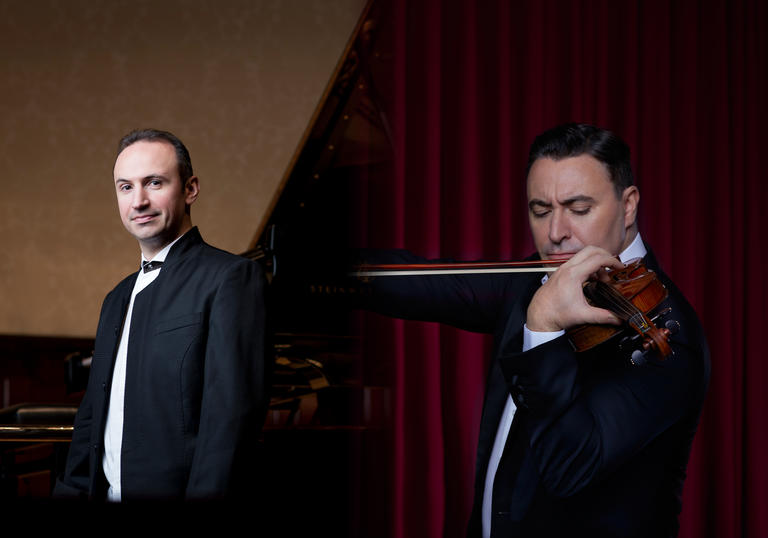
Programme and performers
Wolfgang Amadeus Mozart Violin Sonata No 21 in E minor
1. Allegro
2. Tempo di Menuetto
Sergei Prokofiev Sonata No 1 in F minor
1. Andante assai
2. Allegro brusco
3. Andante
4. Allegrissimo – Andante assai, come prima
César Franck Violin Sonata
1. Allegretto ben moderato
2. Allegro
3. Ben moderato: Recitativo-Fantasia
4. Allegretto poco mosso
Maurice Ravel Tzigane
Maxim Vengerov violin
Simon Trpčeski piano
Artist biographies
Universally hailed as one of the world’s finest musicians, and often referred to as the greatest living string player in the world today, Grammy award winner Maxim Vengerov also enjoys international acclaim as a conductor and is one of the most in-demand soloists.
Born in 1974, he began his career as a solo violinist at the age of five, won the Wieniawski and Carl Flesch international competitions at ages 10 and 15 respectively, studied with Galina Tourchaninova and Zakhar Bron, made his first recording at the age of 10, and went on to record extensively for high-profile labels including Melodia, Teldec and EMI, earning among others, Grammy and Gramophone artist of the year awards.
In 2007 he followed in the footsteps of his mentor, the late Mstislav Rostropovich, and turned his attention to conducting and in 2010 was appointed the first chief conductor of the Gstaad Festival Orchestra.
Recent Highlights include Mr Vengerov opening the season of the Orchestra Filarmonica della Scala with Maestro Chailly, a Residence with Monte Carlo Philharmonic and the Philharmonie in Paris and extensive recital tours throughout the world.
In January of last year, Maxim Vengerov became Classic FM’s first solo Artist in Residence and released a new recording of Tchaikovsky's Violin Concerto with conductor Myung-Whun Chung and the Orchestre Philharmonique de Radio France, coupled with works by Saint-Säens and Ravel as well as a live recital from his Carnegie Hall concert in October 2018. Further recordings will follow to coincide with Maxim Vengerov’s celebration of 40 years on stage at the Royal Albert Hall, originally planned for June 12, but now rescheduled to September 2022. He will be joined by his colleagues Misha Maiski, Martha Argerich, the Oxford Philharmonic with its Music Director Marios Papadopoulos and students from the Royal College of Music London.
As one of Mr Vengerov’s greatest passions is the teaching and encouraging of young talent, he has held various teaching positions around the world. He currently holds the Stephan and Viktoria Schmidheiny Stiftungsprofessor at the Mozarteum University Salzburg and since September 2016 he is also the Polonsky Visiting Professor of Violin at the Royal College of Music in London. In 2018 Maxim Vengerov became the Goodwill Ambassador of the Musica Mundi School - a unique institution, which supports young talents. With the aim of making musical support generally accessible, he initiated his own online teaching platform in January 2021: www.maximvengerov.com
Mr Vengerov has received numerous awards including Grammy Award for Best Instrumental Soloist Performance and a World Economic Forum Crystal award in 2007, honouring artists who have used their art to improve the state of the world, as well as the Ordre du Chevallier from the Palace in Monte Carlo where he resides.
He plays the ex-Kreutzer Stradivari (1727).
